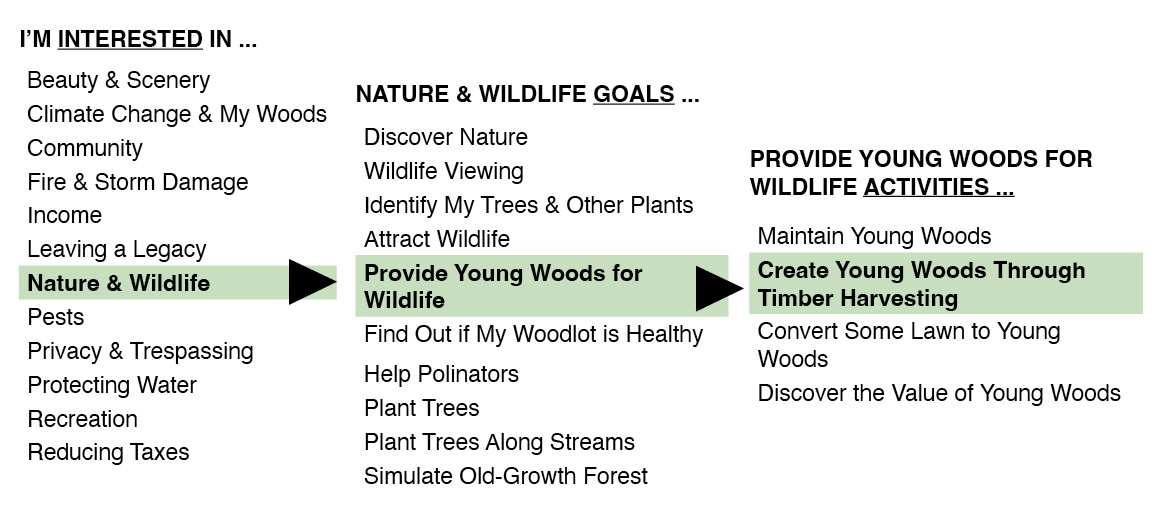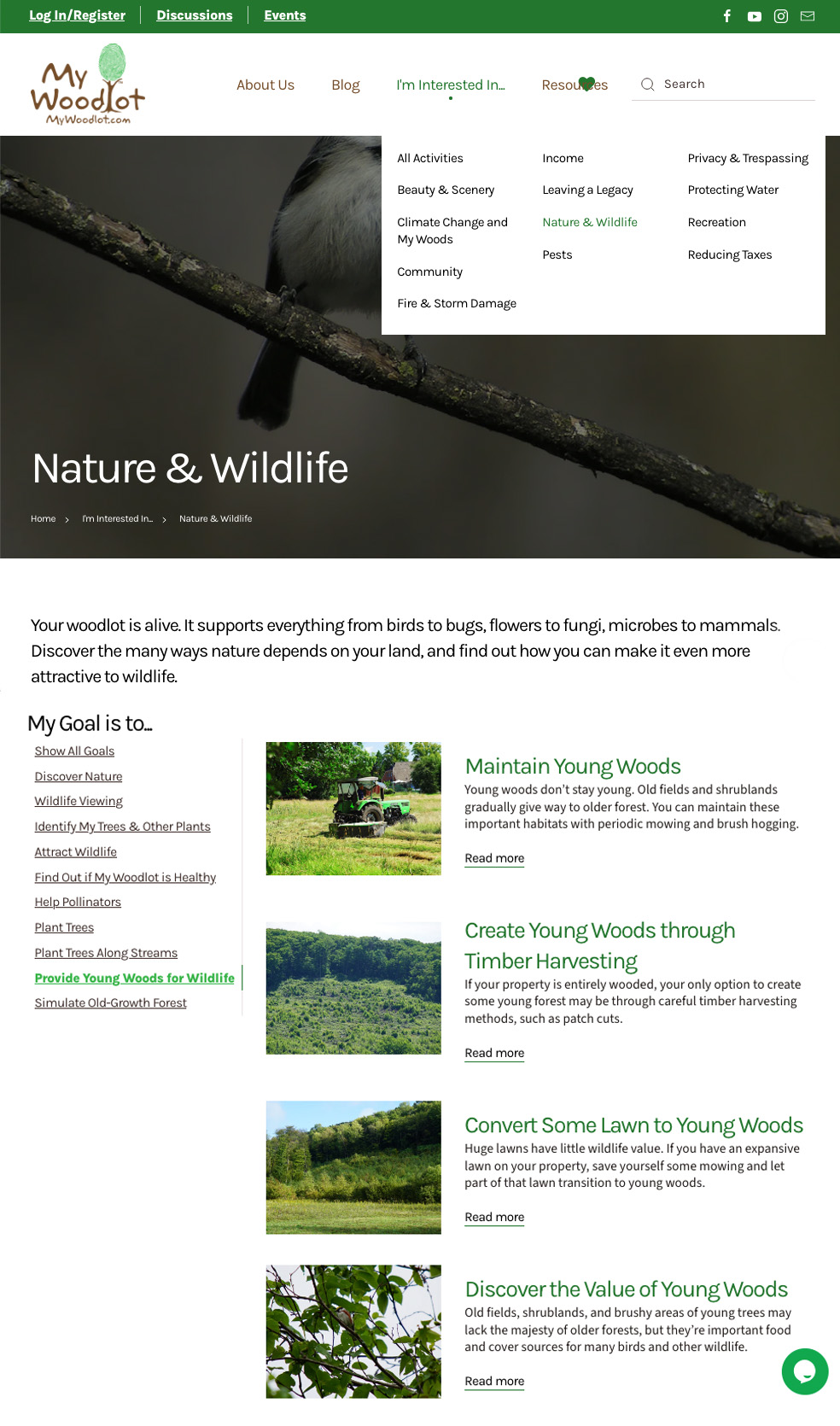A Core Awakening
MyWoodlot.com is a website we developed to help forest landowners make good choices when it comes to managing their land. The site is now 10 years old and has transitioned through two (very different) website developers, the latter leaving me shaken to the core.
NYC Watershed Explained
I work for a not-for-profit organization in New York State and our focus is sustaining a working and economically viable landscape in the New York City (NYC) Watershed region while protecting water quality around NYC’s reservoirs.
The infrastructure for NYC’s drinking water supply is astounding. It is one of the largest surface water storage and supply systems in the world. It is gravity-fed, unfiltered, referred to as the “champagne of tap water” and it's said to be the secret behind NYC's famous bagels.
There are 19 reservoirs in this system that deliver 1 billion gallons of water a day to 9 million consumers in NYC. The water from these reservoirs, located in upstate New York, travel up to 125 miles through streams and underground aqueducts to reach NYC. The NYC Watershed area (the land that drains into the reservoirs) covers over 1.2 million acres. Over 900,000 of those acres are forested and approximately 500,000 of the forested lands are privately owned.
I work in the Forestry Department, as the Outreach Specialist. My department provides forest landowners and forestry professionals in the NYC Watershed with incentives to make good decisions when enjoying, stewarding, and managing their forestland, all while keeping water quality protection in mind. Participation is entirely voluntary. There are 30,000+ private forestland owners in the NYC Watershed, and in 2014, we needed a cost-effective way to reach them to provide ideas, options and information to help them understand and take care of their land. The idea to build a website was settled on.
The Birth of MyWoodlot
Owning forestland, or a woodlot, can be overwhelming. The options and ways to take care of it can be complicated and overwhelming, with many landowners not knowing where to start or what resources are available to them. People own woodlots for many reasons. For recreation, privacy, scenery, legacy, and for income, to name a few. Yet there is no one place where landowners can get information, advice and resources to help them take care of their land. In 2014, following extensive business planning and research, we decided to design a website that organized information and resources for forest landowners in one place. A website would be cost-effective and the information on it could be updated to keep things current and relevant within a dynamic and changing environment.
We had the idea to create a selection-type process to help these landowners with ideas, resources and information to help them enjoy and/or manage their land.
First, the landowner would pick an area that interests them. We developed a list of forest landowner interests based on US Forest Service research. From there we came up with a variety of goals tailored to that interest. Once a goal is selected on, the landowner can then pick an activity that can help them work towards that goal. Within these activities there is a series of “how-to” information to complete that activity. The how-to information can be in many forms such as videos, PDF worksheets, links to specific websites/articles, success stories, and access to professionals. Landowners could have several goals across different interests resulting in lots of activities. These activities could then be saved to provide the landowner with an individualized “plan” for their forest.
This process would work by encouraging landowners to take smaller, less intimidating steps, that would eventually lead to them completing larger goals, inciting good, active forest stewardship.
The following diagram shows the Interest > Goal > Activity selection process idea.

The Development of MyWoodlot
In early 2015 we sent out a bid request to develop MyWoodlot.com and contracted with a web developer consultant shortly after. They made the case to use Joomla, and despite having never heard of Joomla, it seemed to make sense. I’d used a little Contribute and WordPress so I’d put myself at a 2/10 as far as website knowledge goes, but I was willing to broaden my skillset.
The entire site had been mapped out and content developed before the developer was brought on board and, as the project coordinator, I was heavily involved with the site build, learning parts of Joomla throughout. The site was launched in November of 2015 and was well received. We made small improvements over the following few years and mainly focused on adding more content. Then in 2020, due to procurement requirements, we had to re-bid the website contract. Timing-wise this was not a bad thing. We were running into issues with the current site and it needed a refresh. We ended up hiring a different Joomla developer to overhaul the site and provide maintenance. Coincidentally the new developer was also in upstate NY and used to coordinate a Joomla Users Group in that area, that’s how I initially found him.
The Lightbulb Moment
I handed the new developers a headache of a rats nest. It didn’t phase them. They blew it up and loved it. They tore the site down and built it back in Core Joomla and it was profound. I HAD NO IDEA that Core was so powerful and flexible. TAGGING – WHAT?! You can do what with tagging? They eliminated a whole host of problematic third-party components with custom coding and overrides that had become making Joomla upgrades complicated, unpredictable and in the case of some components - impossible. They gave the site a new template, completely restructuring it internally but keeping everything categorized within the Interest, Goal, Activity selection format.
Again, I was involved deeply in the process. Learning from the developers as we went. Like I said, I had no idea of the capabilities Core Joomla offered. I had never been shown the basics until then. I remember remotely attending a Joomla Day USA not long after we contracted with the new developers. I sat in on Laura Gordon’s “Intro to Joomla” class and I don’t think she was 10 minutes in before I realized just how much I had missed out on by not learning the basics. I had been swimming at the deep end with the original site, without learning in the shallow end first. So as usual, I’m doing things in reverse. Like the time I learned to ski by hopping on a chair lift and going to the very top of the mountain first... I lived. Just.
We were up and running with the new site in much less time than predicted and the transition was seamless. At least it looked like that on my end, maybe they were paddling away like mad underneath the surface, but I couldn’t tell... Well done to them, seriously.
The developers were, and still are, very patient with me and all my questions. I ask a lot! If I need them to do something to the site outside my capabilities they graciously walk me through the process so I can learn, and therefore do it myself in the future. The site rarely requires maintenance. It’s trouble free for the most part and it only uses only a few popular and well documented components (lesson learned) including EasyDiscuss, Events Booking and MyShortlist.
After the initial site refresh and template change in 2020, and aside from upgrades and the odd bug that I can’t fix, I do most of the work within the site. I add Blogs and Events weekly, I add new “activities” landowners can do as we develop them, and I can make changes to the templates in YouTheme. I don’t know if this makes me a great client or not?!
The site now boasts 12 Interest Areas, 60 Goals, 250 Activities and 847 pieces of How-to Information. It also has over 360 Blogs, resource listings of forestry professionals, and other tools for forest landowners. I get great feedback from users and it has cut down on department staff time by providing an outlet to send the many people who call requesting information that takes a lot of time to explain. Imagine having to explain the nuances of the New York State Forest Tax Law (yawn) several times a week to people calling our office. Now we can simply send them to “Understand NYS Forest Tax Law” on MyWoodlot and they can get everything they need from there and more.
The following image shows the Interest > Goal > Activity selection process being used on the current site.

Due to procurement, we are currently in the process of bidding the website contract out again and fingers crossed we can stay with the current developers. Although we have no future plans for big changes to the site (template changes would a breeze now it’s Core), I am always looking for inspiration and features to enhance the site. Maybe I’ll discover some at JDay USA this April 😉
Conclusion
I was asked to provide a conclusion in this article. My conclusion: go back to Core. Keep it simple. Especially when the client wants to be as involved as I am. The lack of complications when using mostly Core is astounding. Just before the overhaul in 2020, I was beginning to feel the same way about Joomla that I do about WordPress! I wish I’d had more knowledge of Core Joomla back at the original build to fight the cause but I got there in the end.
Some articles published on the Joomla Community Magazine represent the personal opinion or experience of the Author on the specific topic and might not be aligned to the official position of the Joomla Project
By accepting you will be accessing a service provided by a third-party external to https://magazine.joomla.org/
 Community Magazine
Community Magazine 
Comments